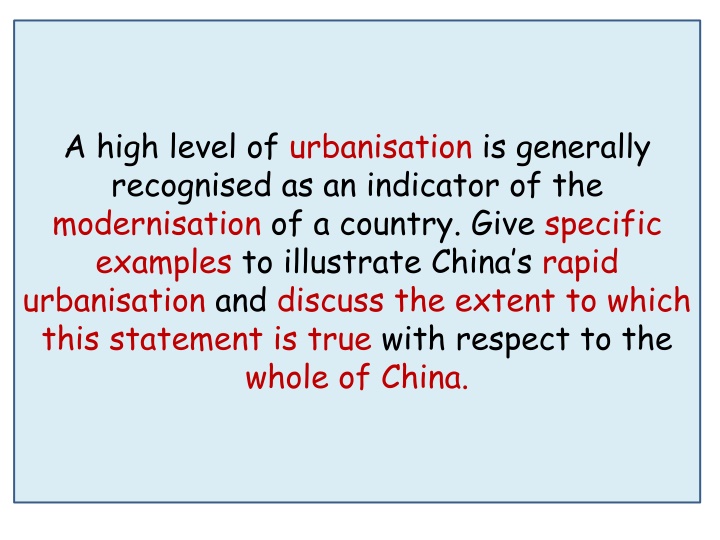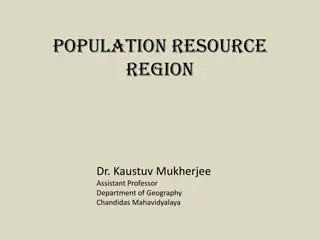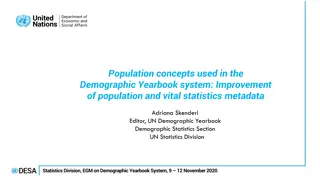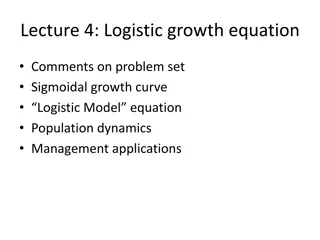
China's Rapid Urbanisation: Examples and Analysis
Explore how China's urbanisation reflects modernisation with specific examples of rapid urban growth, illustrated by the development differences between coastal and inland areas, as well as the economic disparities observed within the country.
Download Presentation

Please find below an Image/Link to download the presentation.
The content on the website is provided AS IS for your information and personal use only. It may not be sold, licensed, or shared on other websites without obtaining consent from the author. If you encounter any issues during the download, it is possible that the publisher has removed the file from their server.
You are allowed to download the files provided on this website for personal or commercial use, subject to the condition that they are used lawfully. All files are the property of their respective owners.
The content on the website is provided AS IS for your information and personal use only. It may not be sold, licensed, or shared on other websites without obtaining consent from the author.
E N D
Presentation Transcript
A high level of urbanisation is generally recognised as an indicator of the modernisation of a country. Give specific examples to illustrate China s rapid urbanisation and discuss the extent to which this statement is true with respect to the whole of China.
A high level of urbanisation is generally recognised as an indicator of the modernisation of a country. Give specific examples to illustrate China s rapid urbanisation and discuss the extent to which this statement is true with respect to the whole of China. Key words what do they mean?
A high level of urbanisation is generally recognised as an indicator of the modernisation of a country. Give specific examples to illustrate China s rapid urbanisation and discuss the extent to which this statement is true with respect to the whole of China. What does the mark scheme say?
East/West development differences Urban/rural development differences Differences between cities: utilities, pollution Chinese cities vs modern cities Rural migrant population. Spatial patterns of cities and housing displacement Encroachment of countryside Large, low paid workforce. A high level of urbanisation is generally recognised as an indicator of the modernisation of a country. Give specific examples to illustrate China s rapid urbanisation and discuss the extent to which this statement is true with respect to the whole of China.
China's coastal provinces are relatively wealthy, and the country gradually becomes poorer the further west it goes.
The second and third maps reveal something a little less obvious. Urban disposable income in coastal cities is much higher than it is in the interior, and rural Chinese people, too, do better along the coast than they do in the interior.
Chinas real gross domestic product (GDP) grew at an astounding 9.6% per year during 1978 -2006. However this growth has not been distributed fairly across China s different regions. Regional disparities relate closely with the development policies of the Chinese government. These policies gave preferential treatment to certain regions in the early stages of the reform. This has had a direct effect on growth by creating an environment that is more responsive to the markets, encouraging international trade and foreign investment leading to economic growth in coastal areas.
Given Chinas size and geography, the regions have played an important role in promoting the country s economic development. Most of China s regional development policies are based on three zones: east,central and west. A regional dimension has been a crucial component of China s development policies. China s development strategy of the 1980s and 1990s strongly favoured the coastal areas and have therefore increased inequality been these and other regions Income differences per capita GDP between China s coastal and interior provinces has been on the rise since the early 1980s when China s urban and industrial reform started. It grew sharply since the early 1990s when larger scale and more intensive reforms began to take place.
The process of globalisation lead to growing inequality between different regions and social groups leading to social conflict in China. https://youtu.be/Kc2DtUehj48 Urbanisation in China https://youtu.be/Kc2DtUehj48 Urbanisation in China
Articles to read... Disappearing villages China s east west income gap widens The great sprawl of China The Hukou system
The Hukou System To have full access to schools and hospitals in the cities at subsidised urban costs, you must have an urban hukou. But if you were born in a rural area then your hukou (and that of your children) is registered there and changing that is very difficult. Only 36% of China's total population are urban hukou holders. This has, in the past, helped control the flow of people and kept urban labour costs down while letting the new urban middle class retain their privileges. The first generation of migrants was happy just to get paid more in the cities. Now many complain about how unjust the system is. The labour of these poor migrants built China s new cities, and they and their children are increasingly angry, because they can t afford to live the Chinese Dream simply because of where they are from.
China wants 60% of its people to live in cities by 2020, putting it broadly in line with the current average for countries with similar income levels. To acheive this, it wants 45% of people to have full urban hukou. This is a huge change. It involves giving full urban hukou to 100m of the 250m migrants. It could be a significant boon to the economy, enabling migrants, who now save a large proportion of their wages because of fears about the cost of health care, to consume more.






















